Where I’ve Been, And Where I’m Going
December 9, 2023 § Leave a comment
Since 2020 I’ve been writing a Substack newsletter, which is why you haven’t seen new posts here. At Substack, Under The Hollywood Sign covers many of the same subjects I’ve covered on WordPress: film, TV, Japan, history–in greater depth, while allowing me to earn money through subscriptions. I’ve also been able to branch out into other areas, notably travel and genealogy.
If you’re interested, you can sign up for only $6 a month at hopeanderson.substack.com. If you can’t pay, there are occasional articles to read with a free subscription–most recently “The Long Shadow of Henry Kissinger”, the first of a two-part installment on America’s greatest war criminal. Next: how Kissinger’s and my paths crossed because of Jim Thompson, the subject of my first two documentaries. I look forward to seeing you there.
-Hope Anderson
The Return of Peter the Hermit
September 27, 2021 § Leave a comment
I’ve written many times about Peter the Hermit, the first of the Hollywood mascots and a vigorous self-promoter. Although he died in 1968, Peter is well remembered by people who knew him as children in Hollywood and Laurel Canyon. During his lifetime, Peter’s image appeared in paintings, prints and sculptures as well as photographs, both professional and amateur.
Today I heard from Allison Burnett, who wrote:
It gets even better! I just bought an old oil painting of this same photo! I also own a gorgeous photographic portrait of Peter, signed by Peter. That’s how I recognized him in the painting. I would love to post the photo here, but there doesn’t appear to be a way to do that.
Here it is:
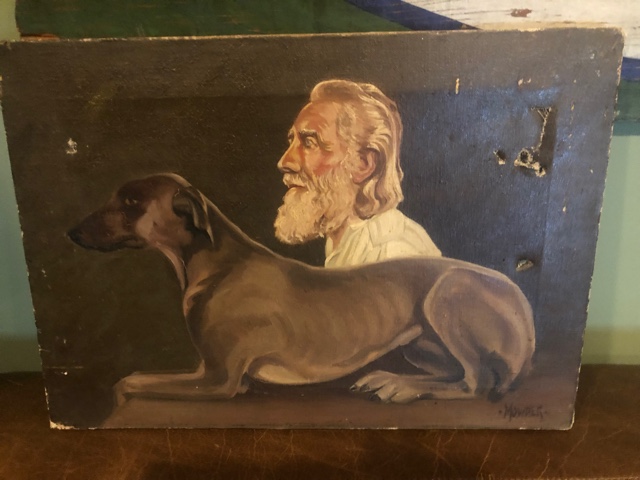
For my previous posts on this unique Hollywood figure, type “Peter the Hermit” into the search bar.
Going to the Movies, Post Pandemic
July 21, 2021 § Leave a comment
On Monday I saw a movie in a theater for the first time in over 19 months. I can’t blame this gap on the pandemic alone, since the last movie I saw publicly was on January 3rd, 2020, when Covid19 was still a Chinese problem. The truth is that I’d been watching at home for years because almost everything–screeners, art films, comedies and dramas–was online. During that time, horror movies and the Marvel juggernaut took over the theaters, leaving me cold. To the extent that I ventured out to the movies, it was to rarely seen films at UCLA Film Archive and the American Cinematheque.
Yet in the nineties, I watched at least three movies a week in cinemas, and scores each year in screening rooms. After Pacific Theaters opened ArcLight Hollywood in 2002, I went there for most new releases, watching them on its fourteen screens or at its flagship Cinerama Dome. For the next decade and a half, I could be found at ArcLight more than any place except home and the gym. And since my gym was located in same complex, it’s not an exaggeration to say that I lived at Ivar and Vine.
The first movie I ever saw at ArcLight was “Training Day”, for me the greatest film of both Denzel Washington and Ethan Hawke. “Training Day” would have been memorable in any setting, but it was a late show in a completely empty theater that made my teenage son and me feel we were in the world’s biggest screening room. The last movie I saw at ArcLight, “Pain and Glory”, was also exceptional, but by 2019 my visits were few and far between. The exception was “Once Upon a Time in Hollywood”, which I saw three times at the Dome in its first five weeks. In October of 2019 I saw Robert Eggers’ “The Lighthouse” at the Dome, never imagining it would my last movie there. But in April of 2021, ahead of California’s reopening, Pacific Theaters announced that ArcLight would close permanently due to its pandemic losses.
The sight of a boarded-up Cinerama Dome was depressing enough for the past year, but its continued shuttering is a blight that symbolizes Hollywood’s slow recovery. Now AMC is rumored to be buying Arclight, including the Dome. If it does, I expect even more action and horror movies, with the odd documentary or foreign film for the rest of us.
No wonder there’s a boom in home theater construction. What used to be a perk of top actors and film executives is becoming a necessity for any homeowner with the room and cash. In Los Angeles, home theaters are the new home gyms: once exotic, now commonplace. Both bring what used to be a public activity into the private realm, which is both a solution and a problem. Though I don’t miss the reek of nachos and the increasingly uncomfortable seats at ArcLight Hollywood, I do miss the laughter, gasps and occasional drolleries of strangers around me. These reactions often enhanced the movies I watched, making me see them in a different light. Home theaters, for all their comforts, can offer no such surprises.
2020: A Year Like No Other For Women Directors (And Women Producers and Screenwriters, Too)
April 6, 2021 § Leave a comment
When Kathryn Bigelow won the Academy Award for Best Director in 2009, breaking into what was arguably the world’s most formidable men’s club, most people assumed that more women directors would follow. But eleven years later, only one—Greta Gerwig, for “Lady Bird”–had been nominated, and she didn’t win. In the two years that followed, the Best Director nominee list reverted to what it had been almost every year since the Academy began handing out Oscars in 1929: five men, almost all white.
Then came 2020, a year of surprising quality and diversity in film. While two women have been nominated for the Best Director Oscar—Chloé Zhao for “Nomadland” and Emerald Fennell for “Promising Young Woman,”—the bigger story is the exponential increase in films directed by women, both here and abroad. One has only to look at the nominations for the Independent Spirit Awards—a better indicator of trends than the hidebound Oscars—to see the difference. Four out of five of the Best Director Spirit Award nominees are women: Zhao and Fennell, as well Kelly Reichardt (“First Cow”) and Eliza Hittman (“Never Rarely Sometimes Always”). It’s safe to assume that Lee Isaac Chung (“Minari”) never imagined being the lone male nominee in any Best Director award category, but there he is.
This sea change in opportunity for women directors began because more women became producers, as both the Academy and Independent Spirit Awards attest. Of the six Oscar Best Picture nominees this year, four have women producers; of the five Spirit Awards Best Feature nominees, three do.
Women screenwriters have also made gains in a male-dominated profession: for the Oscars, two out of five nominees in both the Original and Adapted Screenplay categories are women. For the Spirit Awards, three out of five nominees for Best Screenplay are women, while one of five for Best First Screenplay is. Then there’s the John Cassavetes Award for the Best Feature made for under $500,000, which is given to writers, directors and producers. This year’s nominees include two women writer-directors, one woman screenwriter, and three women producers.
For me, the breadth of the films directed by women is most heartening. With the exception of Bigelow’s “The Hurt Locker,” which not only had an almost entirely male cast but was a war movie, women directors have been nominated for films about women. Given the lack of female stories and protagonists in movies that’s a good thing, but it’s also important to see women directing films about men, the way men have always directed films about women. Kelly Reichardt’s “First Cow,” and Heidi Ewing’s “I Carry You With Me,” two compelling films about male friendship, are a giant step forward. They’re also two of my favorite movies in a stellar year.
Naomi Kawase’s “True Mothers”: Japan’s Superb Entry for the Academy Award
March 10, 2021 § Leave a comment
This review contains plot spoilers
At the outset “True Mothers” seems almost a cliché: a happy couple with an adopted child get an unexpected jolt when his desperate birth mother suddenly appears. Fortunately, nothing is as it appears in Naomi Kawase’s masterful film, and the great pleasure of watching is its uncertainty. What begins as the story of a mother, father and five-year-old son keeps shifting, beginning with a red herring and ending on a surprisingly hopeful note.
In between, we see flashbacks of Satoko (Hiromi Nagasaku) and Kiyokazu (Arata Iura) Kurihara’s struggle with infertility (male, for a change) and their decision to adopt via an agency called Baby Baton, which they discover via a documentary. Impressed by the dedication of its founder, Shizue (Miyoko Asada), the Kuriharas apply, are accepted, and travel to the agency’s island headquarters to pick up their infant son. They also elect to meet his birth mother, a fourteen-year-old named Hikari (Aju Makita), who gives them a letter to read to the baby, called Asato .
Five years later Hikari telephones to demand the child’s return or, alternatively, hush money for not revealing the child’s adoption to his school. The Kuriharas call her bluff. According to Baby Baton’s rules, they have told Asato, his school and the neighbors that he is adopted, an important factor in a country with a long tradition of adopting the children of relatives, friends and colleagues, but little history of adopting the children of strangers. Meeting Hikari in person, the Kuriharas initially doubt her identity, since she barely resembles the middle schooler they briefly.
The film then shifts from Tokyo to Nara, and in flashback becomes Hikari’s story. At fourteen she falls in love with a schoolmate and conceives before the onset of menarche. (Here again there’s a surprise: the boy is kind, also in love, and heartbroken by the events.) By the time Hikari knows she’s pregnant it’s too late for an abortion and—having also seen the documentary–she elects adoption via Baby Baton.
Again and again “True Mothers” defies stereotypes and expectations. The island is tranquil and beautiful, Shizue is kind and motherly, and the other girls—young bar hostesses and sex workers impregnated by customers—are friendly. Hikari’s real troubles start when she returns home to Nara, where her narcissistic mother is concerned only for the family’s reputation and her daughter’s high school entry exams. Devoid of comfort and love, Hikari flees back to the island, discovers Asato’s adoption papers and makes her way to Tokyo. A school dropout and runaway, she ekes out a living near the high-rise apartment where her son is growing up. (Even here there’s a surprise: an employer who not only provides a place for her to live but looks out for her safety and well-being in a perilous time.)
Naomi Kawase, who directed and co-wrote the script with Izumi Takahashi and Mizuki Tsujimura based on Tsujimura’s novel, is the first Japanese woman director to reach the Oscars, an overdue honor for someone who won the Caméra d’Or at Cannes in 1997. Now, nearly thirty years into her filmmaking career, Kawase will direct the official film of the 2020 Tokyo Olympics. She’s a worthy successor to the great Kon Ichikawa, whose “Tokyo Olympiad” has been the gold standard for sports films since its release in 1965.
“Some Things About Yukio Mishima” and Other Recent Posts
February 11, 2021 § Leave a comment
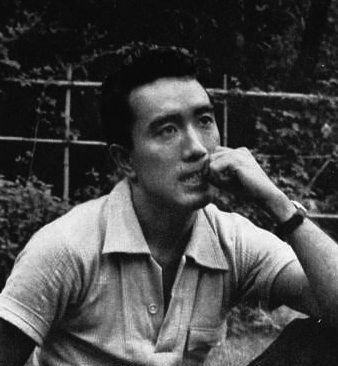
While my newsletter requires a subscription, there are occasional free articles like “Some Things About Yukio Mishima: Remembering A Literary and Political Conundrum, Fifty Years On”. Here’s an excerpt:
| Yukio Mishima…at the time occupied a similar position to Norman Mailer’s: as a serious man of letters with an outré persona that enhanced his fame while detracting from his work. As obnoxious as Mailer could be, Mishima was by far the weirder of the two. While Mailer was busy throwing punches and feuding with fellow writers, Mishima was obsessively pumping iron, establishing a coterie of young right-wing militarists and having himself photographed as St. Sebastian martyred by arrows. Not that I knew these things at the time, since I was eight. |
Check it out at https://hopeanderson.substack.com
Other articles:
Cannibalism: The Ultimate Career Killer: Armie Hammer and the Necessity of #MeToo
Some Things About Yukio Mishima : Remembering A Literary and Political Conundrum, 50 Years On
The Endless Appeal of Writers’ Schedules: And Why They Don’t Matter
What I’ve Watched in Lockdown: A Confession
New Year, New Forum
January 21, 2021 § Leave a comment
Twelve years have passed since I began writing Under the Hollywood Sign. Conceived to promote my documentary of the same name and to further explore Hollywood history, UTHS soon grew to include my previous documentaries, magazine work and interviews. It also spawned two collections of essays. As time went on, my focus shifted to other people’s films, books and TV shows. I also wrote visual art, architecture and Japan, where I grew up, and its rich popular culture. All of this has been a labor of love, and hundreds of posts and pages later it’s time for me to try something new.
Beginning today, I’ll be writing on Substack. In addition to regular posts, subscribers will have access to my other writing–longer non-fiction and fiction–as well new projects, literary and cinematic. Subscriptions are $5 per month, and the link is below. I look forward to seeing you there.
<iframe src="https://hopeanderson.substack.com/embed" width="480" height="320" style="border:1px solid #EEE; background:white;" frameborder="0" scrolling="no"></iframe>
Give the Gift of Documentaries: Under The Hollywood Sign’s December Two-For-One Sale
December 6, 2020 § Leave a comment
Curious about the documentaries that inspired this blog? Here’s a good chance to see them at a bargain price, and to give them as holiday gifts. From now until January 1, 2021, each purchase of a full-length documentary on DVD will include a free companion documentary. Each order of “Under the Hollywood Sign” will come with “Peg Entwistle: The Life and Death of an Actress”, while each order of “Jim Thompson, Silk King, 2015 Edition” will come with “The Jim Thompson House and Art Collection.”
This offer does not apply to digital downloads. To order, please go to: http://www.hopeandersonproductions.com/dvds/
Looking Back With Insight: Oliver Stone’s Masterful Autobiography
December 3, 2020 § Leave a comment
The first time I encountered Oliver Stone–close to twenty years ago, at a restaurant in the Valley–he was so loud and obnoxious that he drowned out the conversation I was having with my lunch partner. ‘Ugh,’ I thought, ‘What an asshole.’ But age has calmed him considerably, and when I heard him speak at a screening of “The Doors” last year he was thoughtful and incisive.
Because I knew little about how Stone transformed himself from Yale dropout and Vietnam War vet to A-list screenwriter and director, I decided to listen to the new memoir Chasing The Light, which covers his first 40 years. It’s excellent, possibly surpassing the high bar set by John Huston for a director’s autobiography (An Open Book, 1980), and filled with insights about writing, directing and the changing nature of the movie business.
For me, the most impressive sections concern his mismatched, complicated and neglectful parents, who met in Paris at the end of World War II, quickly married and returned to New York, where Oliver, their only child, was born in 1946. His repressed, Depression-scarred Jewish father and much younger, flamboyant French Catholic mother had a marriage marked by infidelities and incompatibility that deeply hurt their son. So did their bitter divorce when he was fifteen, yet Stone tells their story with understanding and compassion.
The other highlight of Chasing The Light is Stone’s account of directing, back-to-back, his first two films: “Salvador” and “Platoon”, both of which had harrowing, financially precarious location shoots. Those who don’t make films will find the stories riveting; those who do will be triggered as well as fascinated. In short, it’s a great read, though I recommend Stone’s audio version for the full effect. Happily, a second installment seems to be in the works, and I’m especially looking forward to his account of making “The Doors”.


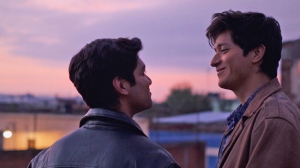
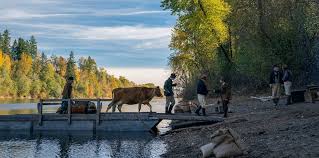


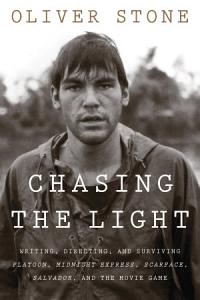


You must be logged in to post a comment.